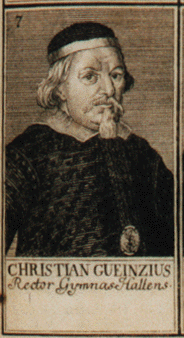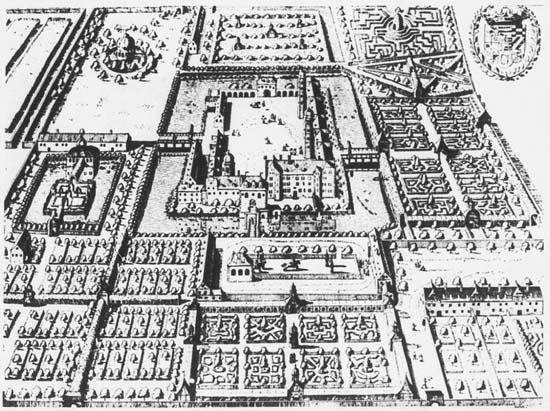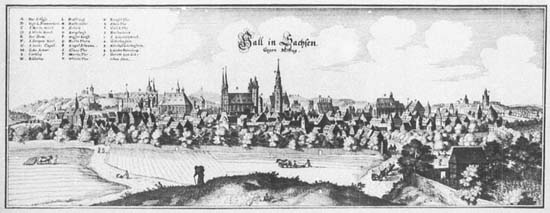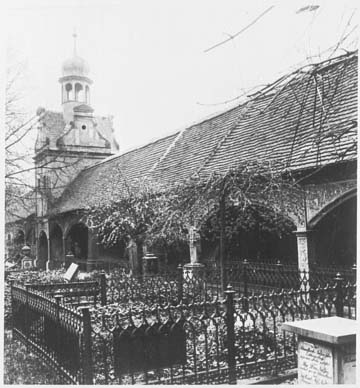Christian Gueintz (Gueinz, Gueinzius, Gueintzius)
|
Updated: 03/29/2002 |
|
He was born on October 13, 1592 in Kolo (Kolau, Kohlo), district
of Guben at the Neiße river (today Koto in the district
of Zilona Góra in Poland). His parents were the preacher
Johannes Gueinzius and Ursula Kretschmar, daughter of the preacher
Daniel Kretschmar.
School education
He was brought prematurely to school in Cottbus under special
supervision of Rector M. Heilando. A conflagration, which the
city almost destroyed [1] lead him to Guben under the principal
M. Trescoyio and in years 1608/9 to Crossen (Krossen) at the
Oder river (today Krosno Odranski, district Zilona Góra
in Poland). Then he learned from 1609 to 1612 with Mr Paeceptoribus
in Sorau (today Zary, district Zilona Góra in Poland).
With an excellent report by rector Bohuslai he left in 1612 to
M. Zacharias Biccio in Bautzen. Of there he was taken at the
Stettin Paedagogium with M. Hunnichium in 1613 [2]. There he
already gave colleges, disputed publicly and in this way he made
his Hebraicum, Graecum and Logicum [3].
|
On this page:
School education
University study
Teacher in Koethen
Rector of the city gymnasium
of Halle
His death
Sources
|
University study
On June 23rd, 1615, he registered himself at the University
of Wittenberg under his rector Valentin Wilhelm Forester J.U.D.
(juris utrisque doctor, Master of Arts of both laws - ecclesiastical
and secular). Because of his neediness, he received an employment
as a house teacher with the philosopher and theologians D. Jacobo
Martini. He was very industrious and disproved three times publicly
in philosophy under M. Weixelbergaro, M. Gutkio and later in
metaphysics under D. Jacobo Martini, so that he already was awarded
a year later, on November 24th, 1616, the academic degree of
the Master by rector D. Ambrosio Rhodio and the dean of the philosophical
faculty, Mr. M. Hettenbachio [3].
Beginning in 1617, he disputed under Balduino about chapter 1
of the letter to the Philippic (super cap. 1 ad Philips.) and
under D. Jacob Martini about the basics of Christian religion
(de fundamento religionis christianae) [2] and gave Collegia
(colleges) about the basics of rhetoric, logic, physics, ethic
and politics.
He then received a series from offers which however he refused.
So as a rector at Znaim today Znojmo in Czechs Republic; from
Count Emrich Turzo was him offered in a personal letter the post
as the rector of schools in Bytchen in Hungarians, and on May
13th of the same year, a call followed to the principal of school
in Banau. From council of the city Grünberg (today Zilona
Góra in Poland) he was invited to a guest sermon and 1618
was him offered the post of the school rector from council of
the city Sagan (today Zagan in Poland) [3].
Instead of this, he remained at the university and 1618 became
adjunct of the philosophical faculty and also disputed about
theological topics.
|

Engraving in Dreyhauptchronicle of 1750
|
 Köthen castle from Merian about 1650
Köthen castle from Merian about 1650
|
Teacher in Koethen
In the time as Duke Johann Ernst of Saxony together with
Prince Ludwig of Anhalt wanted to implement the method of Ratichius,
was it probably Jacob Martini, the teacher of Christian Gueinzius,
who recommended him to the prince [4]. On June 3rd, 1619 he went
for three years to Koethen [3] in order to teach the "Collaborators
and the students" at court [1]. "Zu Hofe lieset
M. Christianus Gueintzius täglich eine stunde, von zehn
Uhren biß umb eilffe für die praeceptorn und Studenten;
die lection soll geschehen aus Luciano oder Homero, und wird
von Ihme der griechischen sprachlehr gebrauch zugleich gewiesen
und getrieben" [5] (At Court M. Christianus Gueintzius
lectured daily one hour, from ten o'clock until eleven for the
teachers and the students; the lecture should hold about from
Luciano or Homero and from him taught in use of the Greek grammar).
There he translated the Grammatica Universales of Ratke
into the Greek in 1619 and edited a Greek reader that he also
translated into the German (Griechische SprachVbung / Jns
Deutsche gebracht / zur Lehr-Art, [Greek language exercise
/ brought into German / for teaching purpose] Coethen 1620) [4].
There he got engaged on May 3, 1621 with Catharina Berndes, the
daughter of Koethen's mayor who has died already in 1616. He
married her on September 10th of the same year [6].
Christian Gueinzius stayed in Koethen even after the shameful
dismissal of Ratich and returned back to Wittenberg with a "strange
reward" in 1622 only in order to study law. Already one
year later, in 1623, he became a lawyer of the Konsistorium (church
court) in Wittenberg, and held legal lectures [1].
|

Wolfgang Ratke, Latinized Ratich[ius], born on October 18th,
1571 in Wilster, district Steinburg, died on April 27th, 1635
in Erfurt, German pedagogue, he inserted among others 1612 to
the upper classes of the German empire convened in Frankfurt
at M. a "Memorial" about the establishment of a homogeneous
German school, in which should taught in "natural"
method [8].
|
|
Rector of the city gymnasium of Halle
On April 4, 1627 the city council of Halle called him to
the rector of the city gymnasium. He should enter upon the succession
of the M. Sebastian Crell passed away before. At the August 1st
of the same year he became introduced into his office [1].
It was the time of the 30-years war when he came into the city.
Halle was in the hands of the troops of Wallenstein since 1625
[7].
Equipped with thorough and comprehensive knowledge, practised
in an expedient teaching method by participation in the experiments
of Ratich he brought into the school, filled with enthusiasm
for youth entrusted to him, he brought the school fast to a high
blossom. He remained loyal to this duty, although the chapter
of the Magdeburg Lay Assessors Court appointed him to an Assessor
in 1636 and he was called in 1645 to a professorship at the University
of Jena [1].
|
|
|
He came into a competence quarrel against the urban music
director Samuel Scheidt about the School Chorus Singers, which
led to the dismissal of Scheidt by the city council in 1630 [9].
"Scheidt has never been high-handed. But in the months,
where him the post of a music director was given, besides the
freedom of creating music the freedom of upbringing a ring of
highly talented young people, ... he was swept away by he frenzy
of an educational imperviousness that exceeded the boundaries
of the allowed. Never before chorus pupils of Halle of the 17th
century have sung more enrapturing, however never more they have
had more exclusive service known as in years 1628 to 1630; but
at the same time they were worse pupils of their school teachers.
This extremely strong heavy-duty of the chorus pupils was the
reason, that brought Scheidt's first great misfortune of his
life.
It began with small quarrels of Scheidt with the colleagues
of the city gymnasium, with open and secret reserve of the boys
of the chorus service, which he paid back with same coin, and
it started, with one from Scheidt not recognised serious warning,
to show his serious face, when the most supreme clerical responsibles
of the new humanistic mind of the gymnasium took care of the
quarrel dominating the school for the first time and restored
the old limited and second-rank chorus service of the pupil with
a stroke: the rector Christian Gueinzius. ... Scheidt began the
fight with obstinacy of the naive human being, and in such a
way, the moment came, where this Christian Gueinzius - as Scheidt
a human being of developmental importance, poet and writer, friend
of the baroque era poets Moscherosch and Harsdoerfer, under the
name 'der Ordnende' (the arranging one) member of the Fruchtbringende
Gesellschaft (fruit-bearing society - an important German language
society) and in the central German school history of the 17th
century one of outstanding personalities prevailed over Scheidt."
In such a way, the city archivist of Halle, Rolf Huenicken, described
the conflict in 1934.
|
 |
| At Easter Sunday 1630 there was no solemn music
performance in U.L.F. (Unser Lieben Frauen = our blessed lady
church) unexpectedly. On Scheidt's part the rector Gueinzius
was blamed to be responsible for this because he hold back him,
Scheidt, the chorus pupils. The quarrel became talk of the town
with Scheidt's viewpoint. After five days the rector let asking
the music director by the preceptor Matthias Doerffel for a declaration
whether he might is the one who circulate of the rumour. Scheidt
wrote an angry letter in that he refused all accusations and
restrictions of the rector brusquely and closed with the threat:
"Before I will have this disgrace and mockery, that he
(the rector) will have the final say, I would rather be a slave-driver
or executioner, because my honest name is more worth than silver
and gold and I do not want to let such name for my children as
one who was be commanded by a school rector." [7] |
Full
wording of the letter |
| In his letter of April 3, 1630, Christian Gueinzius
turned to the city council (wording see appendix page 7). On
December 30, 1630 the Scheidt's employment at the U.L.F. (Unser
Lieben Frauen = our blessed lady church) ended, which is mentioned
in the church records: In this quarter is the director of music's,
Mr Samuel Scheidt's, salary ends." [7] |
Full
wording of the letter |
| In the 17th and 18th century, such a competence
quarrel between the rector of a school and the choirmaster was
not extraordinary. In this case was unusual that Scheidt as a
music director who guided the school chorus did not appertain
to the staff of school. Gueinzius taught itself in music and
complained the disciplinary authority over the pupils and pushes
it through [10]. |
|
 Halle in the year 1635
Halle in the year 1635
|
| Under his leadership, the school
survived hard times. In 1631 the city was conquered by Swedish
troops. King Gustav Adolf himself came to Halle in order to lead
the surrender negotiations with council of the city. This take
place in the house of the principal of the council and Worthalter
(speaker) Karl Herold, whose son married later his oldest daughter
Ursula Elisabeth. In 1632 troops of Tilly and Pappenheim scattered
fear and terrors. In 1636 a plague epidemic broke out, which
3.300 people passed away and the school was emptied except of
a few boys. In 1637 Swedish troops plundered the city but spared
the school. |
 |
|
Two conflagrations took place, on November 1st, 1644 and March
13th, 1645, which brought the school building into highest danger
[1] and annihilated its school library in which a valuable souvenir
of Dr. Martin Luther was: a horoscope, drawn by himself. A pupil
of the rector, Christoph Daniel Schreiber, mentioned it in his
disputation about the movement of the stars on April 12th, 1651.
Translated from the Latin: "Luther left a sky board drawn
personally by himself for midnight November 10th, 1483, its original
Mr Christian Gueinzius, once rector of the Halle Gymnasium, kept
save in its library as a sanctuary. I had been entrusted to him
for care and for upbringing and from special goodwill that he
always showed to me, he permitted me not only to see the same
to but also to copy." [7]
Usually non-resident pupils were included in his house as
for example Daniel Nikolai von Greiffencrantz, later royal Swedish
senior executive officer and chancellor at the duchies of Bremen
and Verden.
|
Institut
Deutsche Adelsforschung (German institute for nobility investigation-
only German) January 9, 2001: "Then he moved for the academic
studies with his relative Joachim Baalck to Wittenberg and Halle,
where he got accommodation at the house of the popular rector
Christian Gueintzius on recommendation of distinguished people.
With him he studied philosophy for two years and defended successfully
some public disputations. In 1633 he moved again from Halle to
Wittenberg where he now studied philosophy and law." |
|
Gueinzius has supported better schoolbooks, above all for
the lower classes and established the school library. School
comedies became rehearsed, which had to be performed in the Waage4
(scale) because of the great rush [1].
The public speeches and debates introduced by him, which were
organised often even on Sundays caused quite a sensation. On
this occasion, Gueinzius let the speakers at first appear in
free position and with movement of the body and therefore he
is considered the inventor as of the actus extracathedrales,
the celebration out of church [1].
He personally has to endure privations in the case for example
when the council of the city could not pay his wages in the war
years [1].
|
April 2nd, 1573
was the start of building for the "Feier- und Hochzeitshaus"
(celebration and wedding house) of the city, which also included
the urban scale. From this function, the building also received
the name "Rats-Waage" (council scale). After foundation
of the university of Halle the auditory maximum was placed into
the first floor of the "Waage" because of lack of a
suitable another building, against which the city indeed inserted
vehement objection failing nevertheless at the final veto of
the elector. The building was destroyed in 1945 with one of the
last air raids; the ruins are removed later. Only the portal
arch was maintained and was set up in the yard of the Moritzburg
(Moritz castle) again. Source: City museum Halle. Source: Stadtmuseum Halle. |
|
In 1641 he was admitted as a member 361 into the Fruchtbringende
Gesellschaft (translation: fruit-bearing society) a famous German
language society with the companion name "Der Ordnende"
(translation: the arranging one). His motto was: "Jedes
an seinem Ort" (each on its location) [4].
Christian Gueinzius was at the city grammar school the educator
of a whole pupil generation under which many later members of
the Fruchtbringende Gesellschaft like Gebhard von dem Werder
(1621 - 1679) no. 386, Paris von dem Werder (1623 - 1974) no.
339, Michael Hermann (1620 - 1666) no. 487, baron Ludolf Lorenz
von Krosigk (1627 - 1673) no. 607, Matthias von Krosigk (1616
- 1697) no. 522 and Vollrath von Krosigk (1612 - 1660) no. 514
[4].
|
Something about the Fruchtbringende
Gesellschaft

|
| But also other famous people, like the poet Philipp von Zesen,
who was pupil on his school between 1631 and 1639. |
Biography about Philip von Zesen (German) |
| He wrote many themes in German philology and
theology. Equally he commented on other questions of time, so
poem against in that time usual ideology, which justify the continuation
of the 30-year war [4]. |
About his importance as Germanist |
| He developed a very extensive literary
activity, which corresponded, to his versatile knowledge. He
above all gained merits with his "Deutsche Sprachlehre"
(German grammar) and "Deutsche Rechtschreibung" (German
spelling). He wrote the today no more customary hymn "Jesu,
Jesu du mein Hirte" (Jesus, Jesus you my herdsman). Although
he was an important Germanist, did he love the roman poetry as
it was usual at his time, and provided each of his many school
writings with small roman distichs, with which he praises the
participants of disputations with funny word games with their
names. In diverse writings, he gave proof of his legal and theological
knowledge [1]. |
Distichon: Verse
units consisting of two verse lines, hexameter and pentameter.
Hexameter: epic verse consisting of six verse feet or six-foot
verse. Pentameter: as an antique dactylic, five-foot verse, which
is employed at the hexameter in the distichon. Dactyl "fingers":
verse foot with a long and two short units or a verse foot [8]. |
|
Also on the field of music he was employed and wrote music
treatises and guided disputations, which are preserved in writing
about the basics of music [9]. His works were based on Calvisius,
Baryphonus, Schneegrass and above all Lippius and dealt with
the musical basics, show the intervals of monocords and teach
them the possibilities of rhythmic variation [10].
He gained great merits around his school. At thankful recognition
by contemporaries as well as by his posterity was not missing
[1]. He was regarded as a most distinguished scholar far out
of Central Germany [4].
|
List
of his works |
|
His death
On February 17th, 1650, he complained about side tinges and
colic. Under medical treatment of the city physician D. Strisser
he could resume his teaching activity. The temporarily occurring
complaints however tied again him to the bed occasionally. When
he then became weak and sick for the third time on March 25th,
the physicians D. Nietnerus, princely court physician, and D.
Engelhard from Koethen were called. However permanent constipation,
sleepless nights, heat and weakness increased so that he demanded
for his confessor, the archdeacons and senior minister Mr Johann
Volckmar, in order to confess and to receive his last Holy Communion.
Then he gave his instruction for his funeral and the supply for
his children and his wife.
In the morning of April 3rd he was very thankful that he still
was allowed to see his name-day [3]. This day was normally inspected
festively and many "votive adclamationes" (dedicating
cheers) became printed to his honours [11]. He called for his
chorus pupils in order to thank his God with music. With it he
has joined in the singing strongly. He finally passed away at
11.00 o'clock at night in his 58th year [3].
His funeral service occurred on April 8th at the school church,
the corpse sermon was held by Gottfried Olearius, dean of the
city churches, premiere priest of the church of U.L.F. and inspector
of the grammar school [3]. He was buried at the school church.
|
 |
|
In the church book of the church of U.L.F., we find the following
entry no. 8 in death register 1650:
"d. 8. Aprilis, die Woche Palmarum, H. Christianus Gueinzius
Rector auff der Schule gest. 3. Aprilis im 58 Jahre aetatis begr.
mit dem gantzen Geläute gratis." (on 8th of April,
the week Palm Sunday, Mr. Christianus Gueinzius Rector of school
died on 3rd of April in his 58th year buried with complete chime,
free of charge)
By his son Johann Christian Gueinzius an epitaph from polished
Esperstaed stone was set at the wall of the school church left
of the altar. Below the image of crucified Jesus and his motto
from the Gospel of John, chapter 15: "I am the vine ..."
were standing the Latin inscription:
"Fige pedem Viator, sitas hic ac terena sui parte positus
est CHRISTIANVS GVEINZIVS, Gubenas Lusatus, J.V.C. & Philosophus,
ejusque Facultatis in celeberrima Acad. Witteb. quondam Adjunctus,
ac Consistorii Elect. Sax ibid, Advocatus Ordin. post Hallensis
Saxo Gymnasiarcha per 23 annos, Illustrissimi a Fructu per Germaniam
Ordinis membrum exellens & perpetuum decus, Vir omni laude
cumulatus. Qui postquam consummati Viri mensuram jam dudum implevisset,
a cunctis mortalium ac illustribus viris cultus, in admiratione
etiam post fata apud eos, qui docentem audiverunt & in scriptis
legunt, Vivere desiit A. MDCL. 3 April ipso nominali die, cum
ætatem exegisset ann. LVIII. m. d. 3. Tanto viro, Patri
pariter ac suavissimo Marito,pientiss. Conjux Catharina Berndes,
quæ mortalitatem exuit Anno MDCLIX ætat. XL. &
bini cum quinque tiliabus infra nominandi, hoc amoris ac memoriæ
monumentum posuere. Memento mori viator & sanctis cineribus
quietem apprecare."
At the end, the names of the children [2].
|
|
 Stadtgottesacker (city cemetary) in Halle
Stadtgottesacker (city cemetary) in Halle
|
 |
|
31 years later he was reburied into grave arch 9 on the Stadtgottesacker
(city cemetery), which his son Johann Christian had bought meanwhile.
The epitaph in his final grave place received following Latin
inscription:
"Hic Christianus Gueinzii ossa quiescunt. Christian Gueinzius,
Guben-Lusat. natus 1592. Christianus fuit fide, humanitate homo;
Istic veræ vitis palnus ob fructum, hic ob odorem rosa
flagrans, Philosophus sua ætate clarissimus, Wittebergæ
enim constitutus Elector. Consist. Advocatus. Una et Philosophiam
& Jura magna cum laude prosessus est, postea Salinarum Gymnasiarcha
Saxonicarum factus, Dexteritate, integritate, sedulitate, &
suam & Gymnasii famam auxit, Docuit enim cum admiratione
præsentes voce, Scriptis absentes. Utilitati certe publicæ
publicus servus serviit ann. 23. Sed serviit! Nunc in cælis
capit mercedem postq. A. 1650. D. 3. April. ipso nominali die
suo servire desiit. Reliquit autem ingens sui desiderium non
tantum conjugi Catharina Berndes & 2 filiis filiabusque 5.
Sed & Gymnas. & univers. literat. orbi. Tu v. Lector,
ne nihil ab hoc Præceptore discas. Disce Mori. Perpetuæ
memoriæ Dn. Parentis posuit Filius natur major. Joh. Christian
Gueinzius, J.U.D. Reipub. Hall. Consul & Consilarius Mansfeldicus,
1681" [2].
(Here rest the mortal remains of Christian Gueinzius. Christian
Gueinzius of Guben in the Lausitz is born in 1592. His spirit
through belief, a human being through his humanity. That through
the fruit as a true tendril of the vine, which he admired, likes
a fiery rose. His life long he was very famous as philosopher,
in Wittenberg he was Churfuerstlichen Consistorial Advocat (lawyer
of the church court of the elector). In the same way he is mentioned
with praise in the philosophy because of his great jurist ability
and gained afterwards to the rector of the grammar school of
the saltworks of Saxony. Through smoothness, unselfishness and
diligence he increased the reputation of the grammar school and
its own. He indeed informed more wonderfully the absentees wisely
by his writings, as he informed the person present by his own
person. Certainly for the common welfare he served as state servant
23 years. Yes he served! In the heaven now, he obtains his wage
after he has stopped on April 3rd 1650 on his name-day to serve.
He left a big desire to him not only with his wife Catharina
Berndes, 2 sons and 5 daughters also with the grammar school
and the whole scholarly world. There you are reader, what does
you tell the life of this teacher. Learn to die. In memoriam
of the son to his father, older than he, Johann Christian Gueinzius
J.U.D. and Consul of the community of Halle and council of Mansfeld
and Deacon 1681."
|
|
Sources
| [1] |
Eckstein, Dr. Friedrich August; Programm
der Lateinischen Hauptschule zu Halle; Halle 1850. |
| [2] |
Dreyhaupt, Johann Christoph von;
Ausführliche diplomatisch-historische Beschreibung ... des
Saal-Kreyses; 1750. |
| [3] |
Olearius, Dr. Gottfried; Des himmlischen
Weinstocks fruchtbringende Reben.....; Leichenpredigt für
Christian Gueinzius; Halle 1650. |
| [4] |
Conermann, Klaus (Hrsg.); Die Mitglieder
der Fruchtbringenden Gesellschaft 1617 - 1650; Weinheim 1985. |
| [5] |
Niemeyer, Hermann Agathon; Wolfgang
Ratichius in Cöthen; Halle 1842. |
| [6] |
Nicandro, Johanne Gottfriedo; Das
girendeWittven-Täublein; Leichenpredigt für Catharina
Berndes; Eisleben 1675. |
| [7] |
Gueinzius, Gotthold; Die Queintz
- Geschichte einer Familie; Berlin 1979. |
| [8] |
Meyers Großes Taschenlexikon;
Mannheim, Leipzig, Wien, Zürich 1992. |
| [9] |
Riemann, Hugo; Musiklexikon; Ergänzungsband
A - K; Berlin 1927. |
| [10] |
Grove, George; Sadie, Stanley; The
new Grove Dictionary of music and musicans; Band 7; London 1980. |
| [11] |
Wentzel, Johann Caspar; Hymnopoeographia;
Teil 1; Herrnstadt 1719. |
|
|
| |
 |





